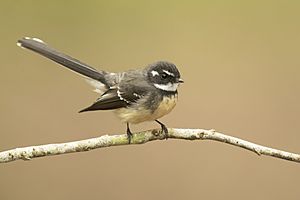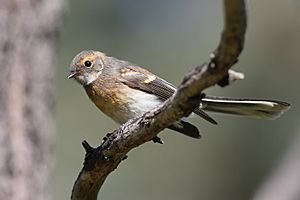Grey fantail facts for kids
Quick facts for kids Grey fantail |
|
|---|---|
 |
|
| Rhipidura albiscapa albicauda | |
| Conservation status | |
| Scientific classification | |
| Genus: |
Rhipidura
|
| Species: |
albiscapa
|
| Synonyms | |
|
Rhipidura fuliginosa |
|
The Grey Fantail (Rhipidura albiscapa) is a small bird that mainly eats insects. You can find this common bird in places like Australia, the Solomon Islands, Vanuatu, and New Caledonia.
Some people think the Grey Fantail is the same species as the New Zealand Fantail. But because their calls sound different, others believe they are separate species.
Contents
What Does the Grey Fantail Look Like?
This bird is usually grey or grey-brown on its back. Its belly is lighter, often yellowish or orange. It has a white throat and white marks above its eyes.
The outer feathers of its tail can be white or have white edges. This depends on the specific group, or race, of the bird.
The Grey Fantail grows to about 16 centimeters (6.3 inches) long. Half of this length is its tail. The bird often fans out its tail, which shows its light outer feathers and dark middle ones. Some groups, like the keasti race, have darker feathers overall.
How Does the Grey Fantail Behave?
The Grey Fantail is almost always moving during the day. It quickly flies from one perch to another. It might land on the ground, but mostly it stays on tree branches or other handy spots. It is always looking for flying insects to catch.
These birds are not shy. They often fly very close to people, especially in forests and gardens. When people walk or dig, they might disturb small insects. The Grey Fantail is quick to catch these insects.
The bird's call sounds like a metallic cheek. It might make this sound once, or repeat it many times like a chattering noise.
The Grey Fantail's Life Cycle
The Grey Fantail protects its own area, called a territory. They breed during certain seasons.
These birds build small, cup-shaped nests. They usually place their nests in the forks of trees. They make their nests from things like moss, bark, and plant fibers. They often use spiderwebs to help hold the nest together.
A pair of Grey Fantails will raise several groups of young, called broods, each season. Each brood usually has three or four cream-colored eggs. These eggs have grey and brown spots.
The eggs hatch after about two weeks. Both the male and female birds take turns sitting on the eggs and feeding the young.
Gallery
See also
 In Spanish: Abanico gris para niños
In Spanish: Abanico gris para niños






